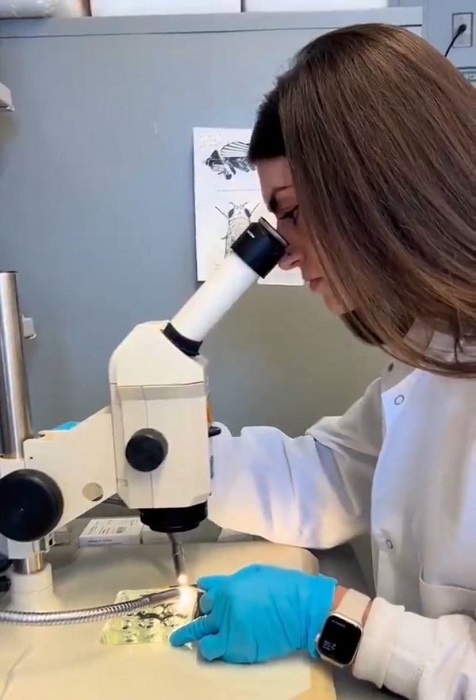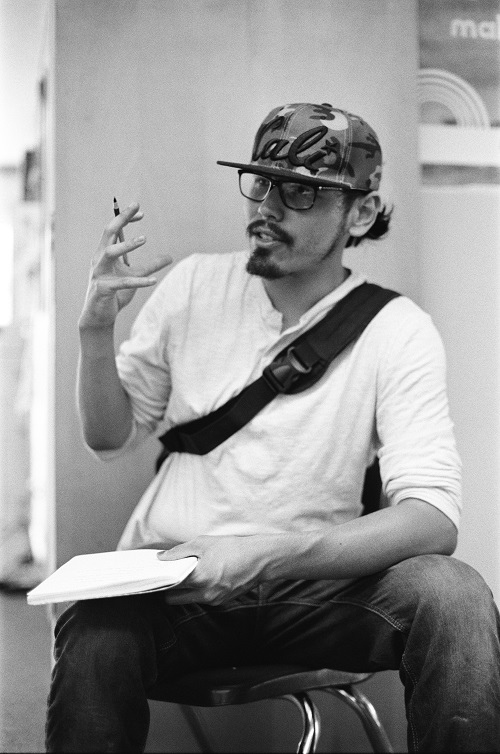In March, when reports began circulating about some research universities reducing the sizes of their PhD cohorts and, in some cases, rescinding offers to accepted students, Mathew Sarti remained optimistic.
Sarti graduated from the University of California Santa Cruz (UCSC) with a bachelor’s degree in neuroscience in 2024 and has been working in a UCSC lab studying the complex neurological structures that produce birdsong in Bengalese finches. As the first person in his family to attend college, he leaned on mentors to guide him through his applications to graduate school, where he planned to continue his neuroscience research on avian models, with the hope of someday running his own lab.
Sarti applied to 12 PhD programs, as his advisors recommended. But this was before February, when the National Institutes of Health (NIH) announced plans to reduce funding to research universities by capping payments for indirect costs, which support institutional resources such as the upkeep of laboratories and equipment, security, and other administrative expenses associated with conducting research.
A judge has issued a permanent injunction on the cuts following a lawsuit against them filed by the Association of American Medical Colleges (AAMC), the American Association of Colleges of Pharmacy, the Association of Schools and Programs of Public Health, and other organizations representing academic research institutions. The U.S. government recently appealed this decision.
Universities could face a loss of funding totaling $6.5 billion nationally if the cuts are implemented. In addition, the NIH and its parent agency, the Department of Health and Human Services (HHS), have terminated research grants for projects that were flagged as related to initiatives that are disfavored by the current administration, including some focused on racism, women, people who identify as LGBTQ+, climate change, and COVID-19.
As a result, some institutions have begun to cut back on spending as funding uncertainty looms.
For many applicants to PhD programs, such as Sarti, this has meant delayed admissions decisions, higher rejection rates, and rescinded offers.
“There’s been fear among us prospective graduate students that we’re not secure even if we have an offer,” Sarti says. “I was thinking it would be OK, but it did happen to me.”
Sarti says he had been offered a fellowship at one program and was given a deadline of April 15, 2025, to accept. The university was far from his family in California, so he confirmed that the offer was valid until the deadline, which would give him time to consider other offers. But at the end of March, he received notice that the university was deferring his acceptance to the program for a year due to funding uncertainty.
“Institutions are committed to training the next generation of biomedical researchers and also need to ensure that they have resources to support trainees,” explains Elena Fuentes-Afflick, MD, MPH, chief scientific officer at the AAMC. “Many graduate students and postdoctoral scholars are supported on faculty investigators’ grants, particularly NIH-funded grants.”
The impacts of even temporarily shrinking PhD cohorts could have ripple effects on research and the future biomedical workforce, says Jordan Green, PhD, the Herschel L. Seder professor and vice chair for research and translation in the Department of Biomedical Engineering at Johns Hopkins University.
“There is going to be a lot less STEM talent getting educated all around the country, so many trainees are not going to come to universities and create cures and solve challenges. There will be less research going on in labs, less intellectual property invented, fewer companies created, less medicine out in the world over the next five to 10 years,” Green adds. “It’s affecting us now, but also in a way that the impact is going to be long-lived. It’s really making America go backward.”
Funding cuts
The number of people awarded doctorate degrees in science and engineering fields in the United States has steadily increased over the past few decades, particularly since 2002, according to the Survey of Earned Doctorates. In 2023, the most recent year for which data are available, a record 45,533 people earned science or engineering doctorates, up from 26,136 in 2002, and a total of nearly 270,000 students were enrolled in full-time doctoral programs.
Doctorate programs are research intensive, can take four to six years to complete, and are generally funded through a combination of university and external funding. The NIH, which is the largest funding agency of biomedical research in the world, awarded 83% of its $48 billion annual budget to approximately 300,000 researchers at more than 2,500 universities, medical schools, and other research institutions across the United States in 2022, according to the NIH website.
But in February, news of significant planned changes to NIH funding began to emerge, and in late March, HHS announced sweeping plans to reduce its workforce by almost a quarter.
The federal government has also announced targeted funding cuts of hundreds of millions of dollars to several high-profile research universities, including Columbia University, the University of Pennsylvania, Princeton University, Cornell University, and Harvard University, based on allegations that the institutions failed to protect students from antisemitism, or, in the case of the University of Pennsylvania, allowed a transgender athlete to compete on a women’s swim team.
Among the many programs impacted by federal cuts is the Maximizing Opportunities for Scientific and Academic Independent Careers (MOSAIC) program, of which the AAMC is a grantee. It has offered mentoring and career support to researchers from groups that are underrepresented in medicine during their transition to academic research faculty positions.
“The MOSAIC program has provided invaluable professional development and mentoring support for individuals at a formative phase of their career,” explains Fuentes-Afflick.
With the uncertainty of future funding, many researchers and prospective graduate students are concerned that the future of both biomedical research and their livelihoods is in jeopardy.
Johns Hopkins University laid off more than 2,000 employees as a result of federal funding cuts to the United States Agency for International Development, and more than a dozen universities announced hiring freezes in March. Green says the biomedical engineering PhD program also reduced its accepted cohort by about half.
Jennifer Unger, PhD, the director of the PhD program in Health Behavior Research at the University of Southern California Keck School of Medicine, says that her lab usually accepts 15 graduate students, with the hope of having a cohort of 10, but this year it accepted only six students.
One crowdsourced Google spreadsheet has gathered unverified reports of reductions in doctorate acceptances and rescinded offers from dozens of university programs across the country.
Isaac Lock, a biological engineering major at the Massachusetts Institute of Technology who will graduate this spring, believes the cutbacks resulted in his being accepted to fewer PhD programs than he expected. It also meant he was quick to commit to a program as soon as he was accepted, for fear of losing his offer.

Courtesy of Isaac Lock
“My long-term goal is to end up in academia,” Lock says. “But it seems academia has been under attack. There’s a rise of anti-intellectualism in America. [An academic career is] still my plan for now, but if things don’t take a turn, there’s a real possibility I’m going to have to consider other options.”
Green worries that the uncertainty surrounding the field will have ripple effects even beyond this year’s PhD cohorts.
“It’s not just one spot in the training pipeline being affected — it’s in almost every spot,” he says. “Some budding scientists thinking about going into this field are starting to think, ‘Maybe I can’t go into biomedical research.’”
And without biomedical researchers, progress on treatments for diseases will stall, he says. For example, Green is codirector of an NIH-sponsored center for immunoengineering that is working on programming mRNA to retrain immune cells in children to cure type 1 diabetes. The technology could also be applied to other autoimmune diseases, such as multiple sclerosis (MS) and Crohn’s disease.
“Instead of using a pill to treat the symptoms of cancer, cardiovascular disease, MS, etc., what we will soon be able to do with these new medicines is go into the root cause of a disease and treat it on the molecular, genetic level,” Green says. “It’s a tremendous opportunity, and we’re hitting the breaks.”
Readjusting to uncertainty
Alyssa Connell took two gap years after completing her undergraduate degree to work in a lab at Penn State University, researching neurodegenerative disorders and bolstering her applications to 20 MD-PhD programs.

Courtesy of Alyssa Connell
“It was a grueling process, for sure,” she says.
It was all worth it when she received her acceptance to an MD-PhD program. Not only would she be able to pursue her dream of becoming a physician-scientist, but her tuition would be funded.
“It felt like a weight had been lifted off me,” she says.
But plans changed when the university announced it was rescinding several dozen PhD offers due to funding uncertainty, though it would offer priority consideration for this year’s accepted students in a future cohort.
Connell says she still plans to attend the medical school this year but will have to scramble to apply for loans to cover her tuition and living expenses.
“After I got over the initial shock, I realized I was still incredibly fortunate to have this MD acceptance,” she says. “I feel deeply for all PhD-only applicants who have no avenue to continue forward.”
Sarti, the neuroscience PhD applicant, experienced a roller coaster of emotions the day his offer was rescinded, because the same day he received notification of acceptance from another program that was his top choice.
Still, his excitement is tempered with the sobering realization that academic careers may be changing in ways that could jeopardize his plan to have his own lab. That is, unless academia can reclaim the public’s trust.
“The reason why funding is uncertain is because the American people themselves have lost their certainty about academics,” Sarti says. “It’s on us — as scientists, researchers, academics. We have to represent ourselves in the culture and make sure people understand it’s not some political campaign or agenda; we’re trying to benefit society.”


